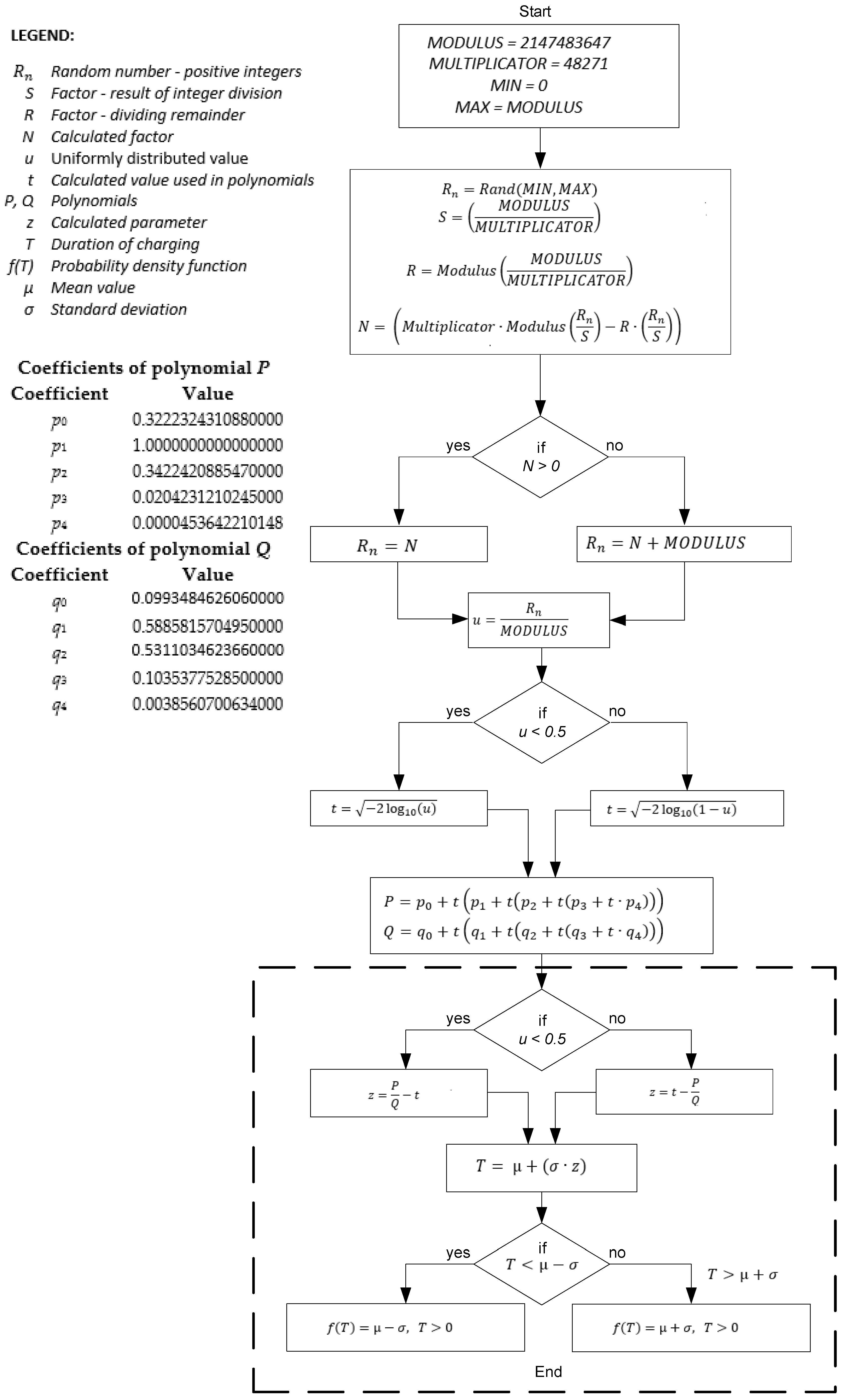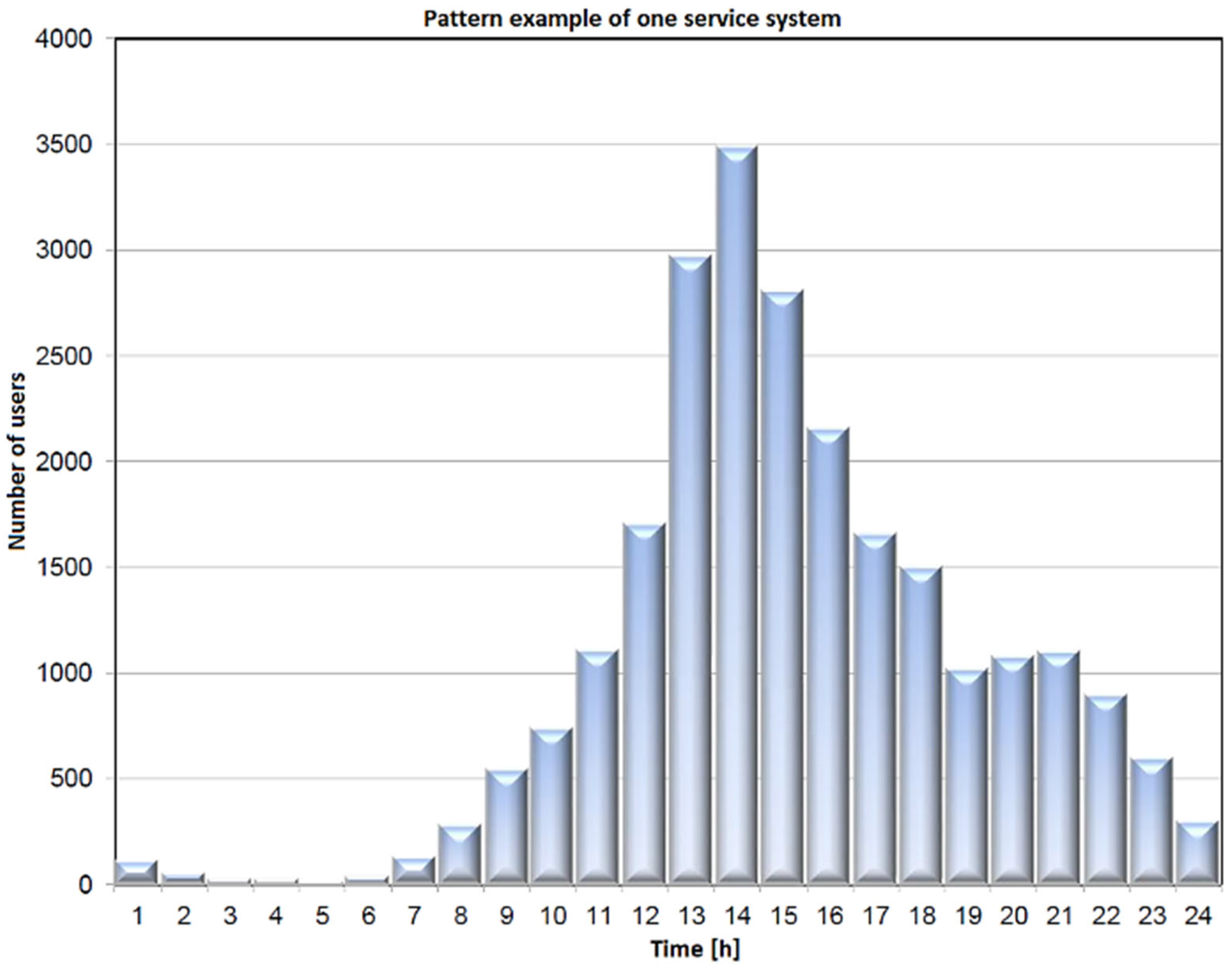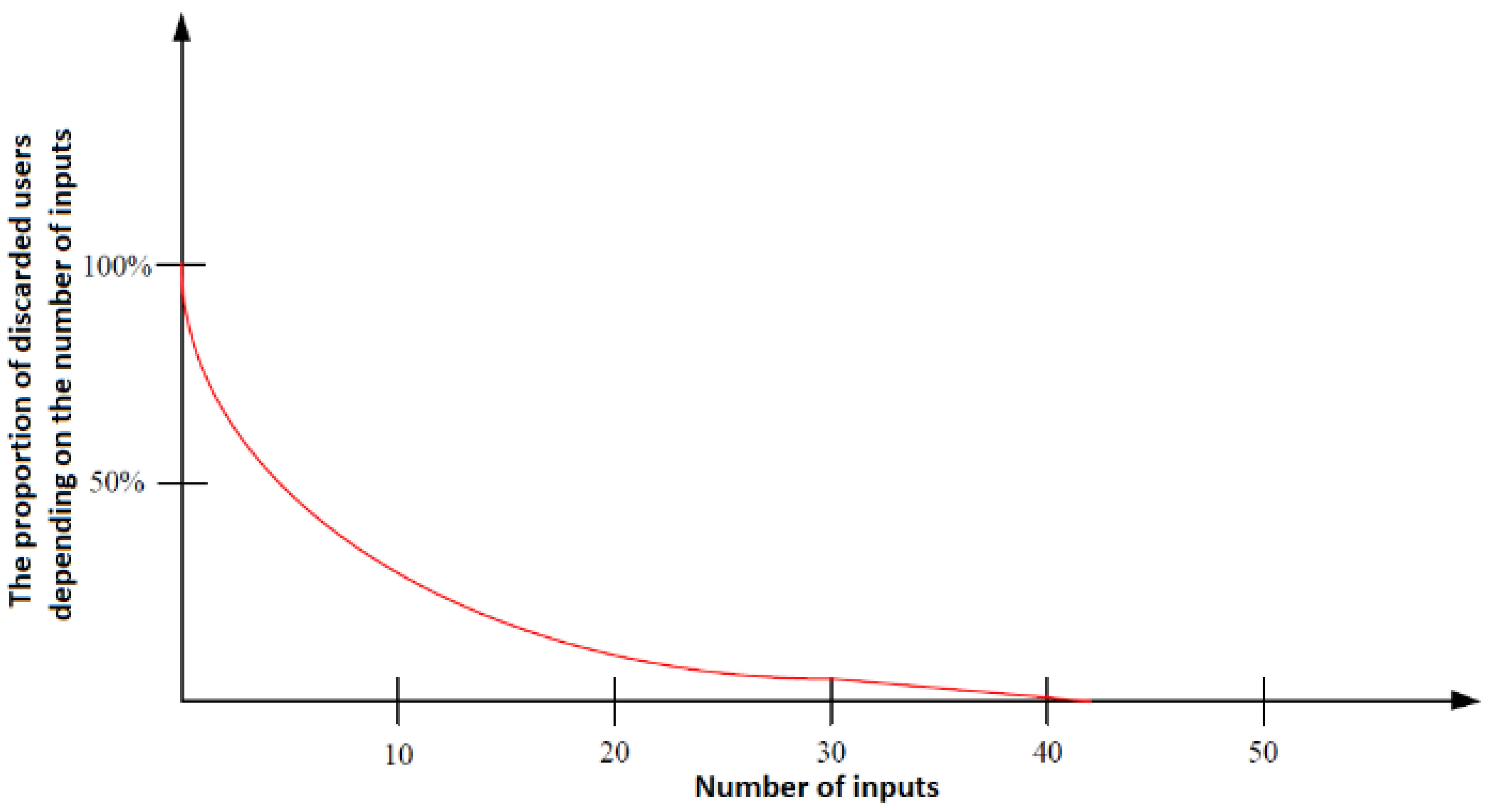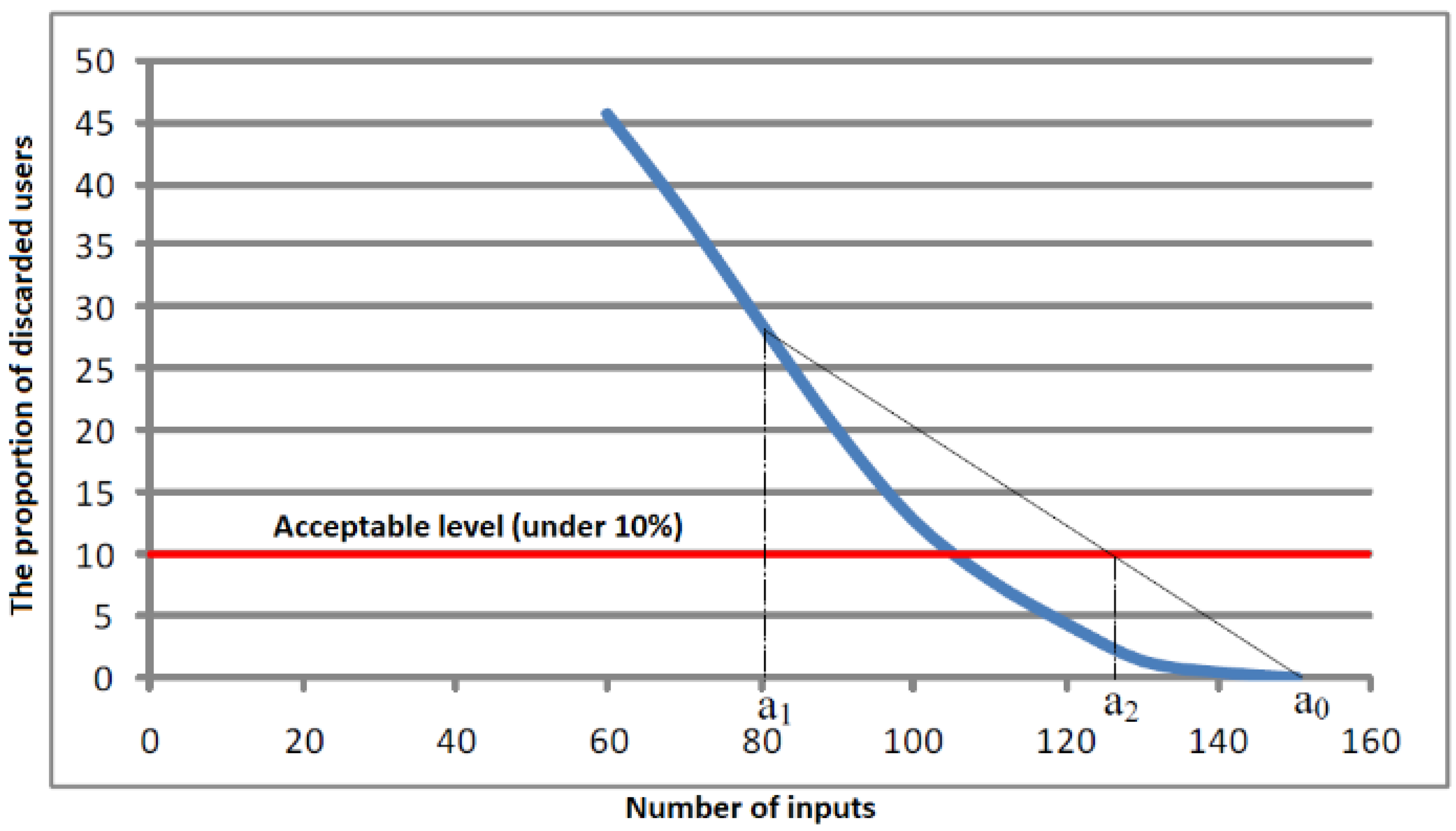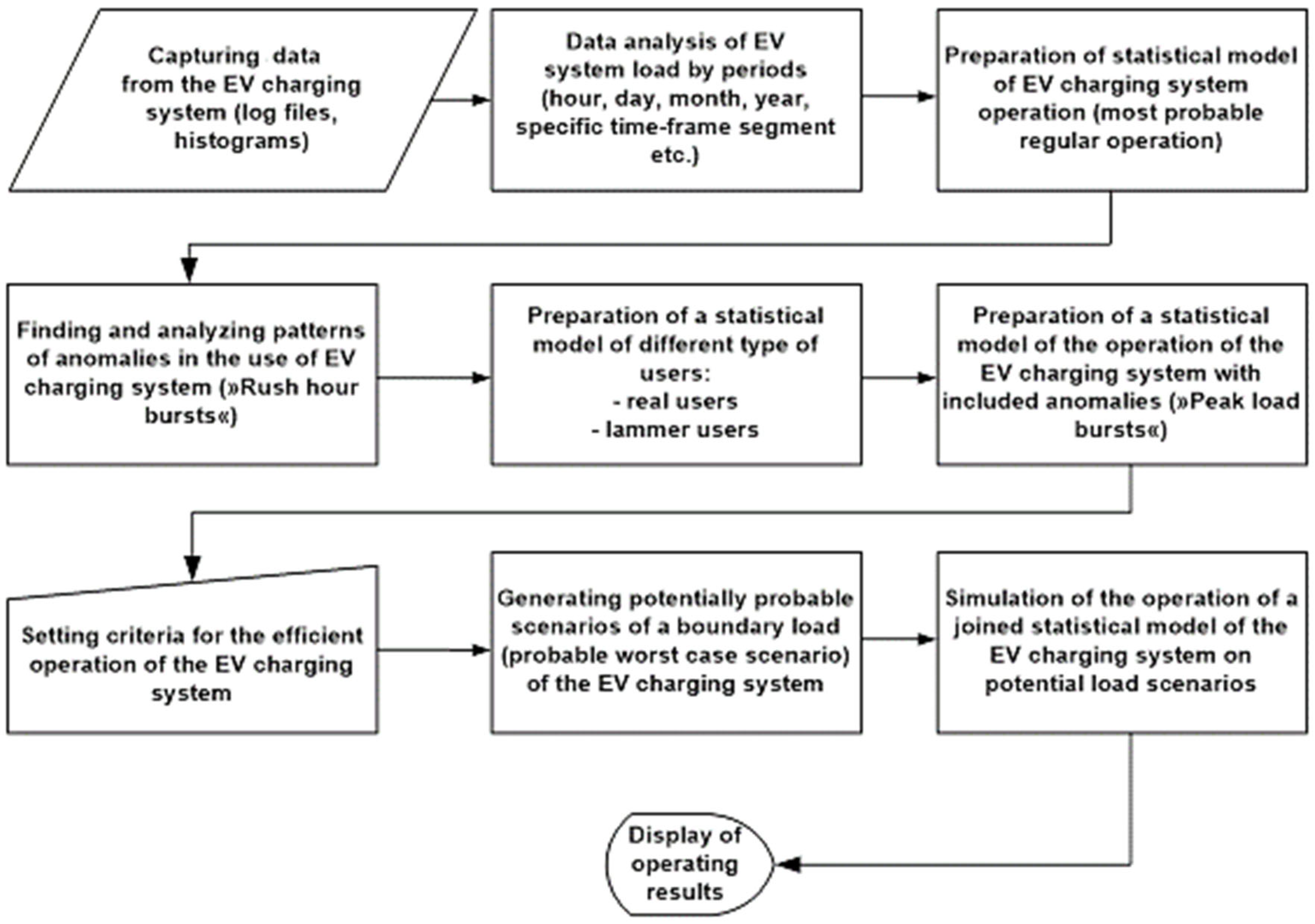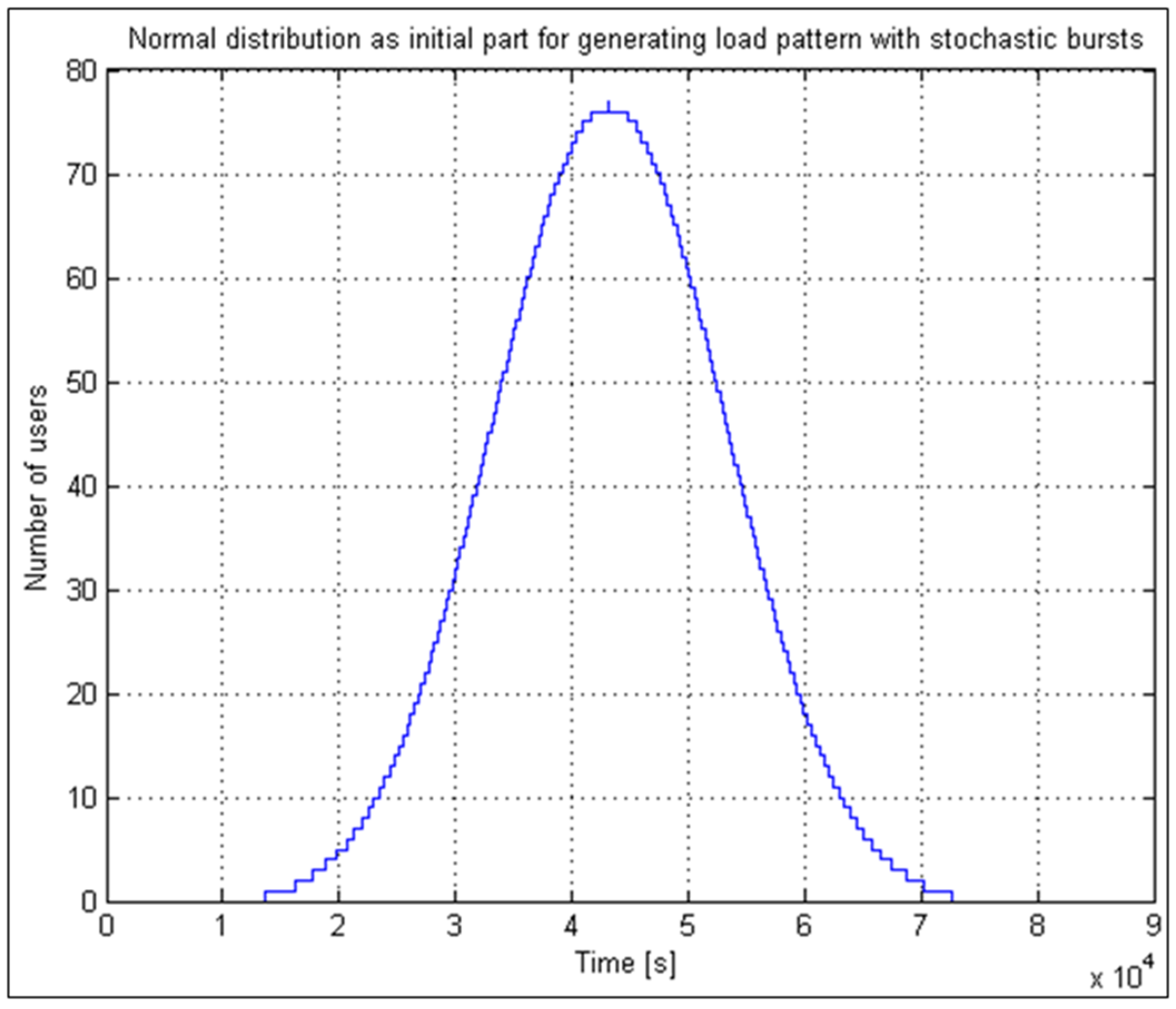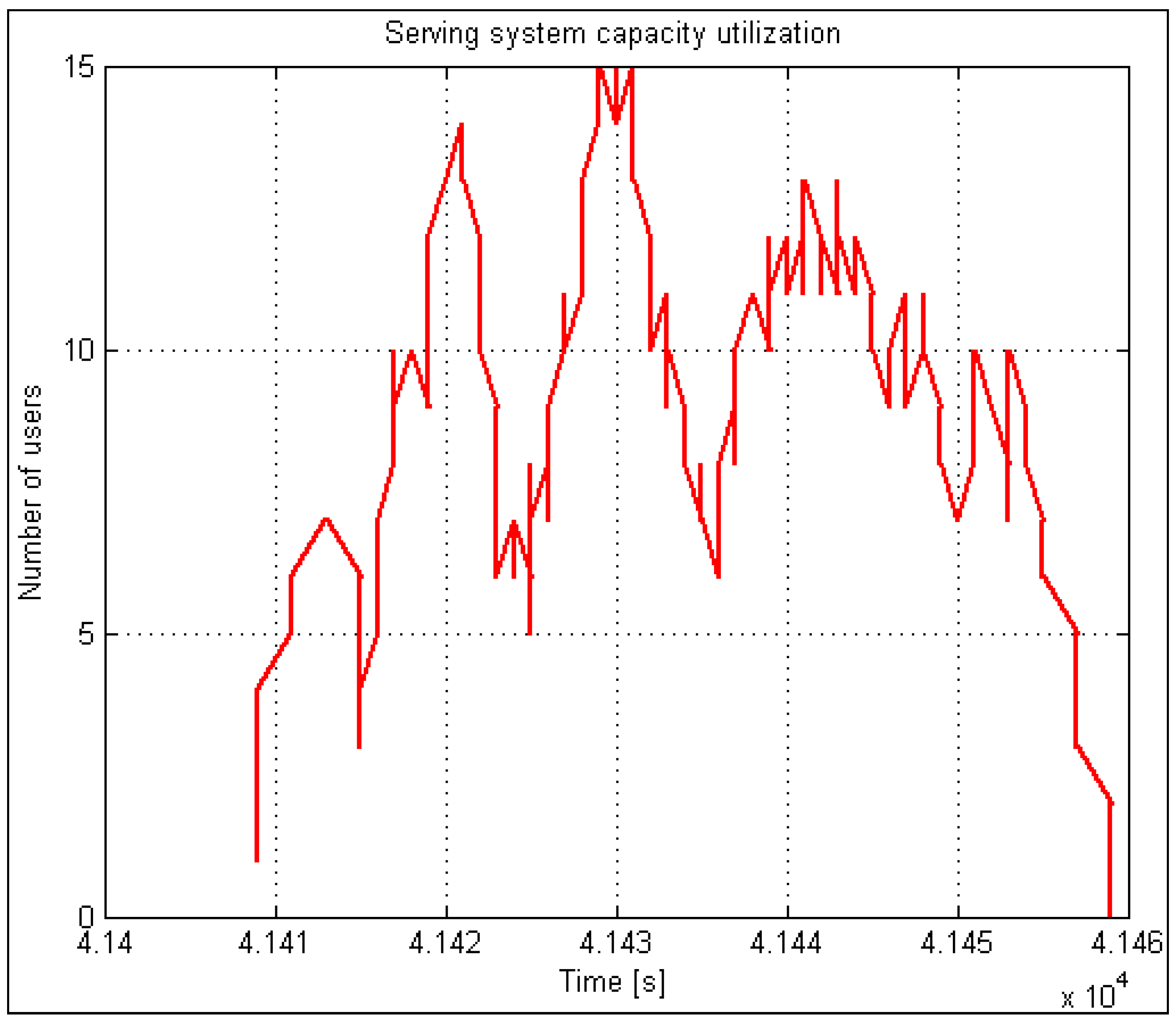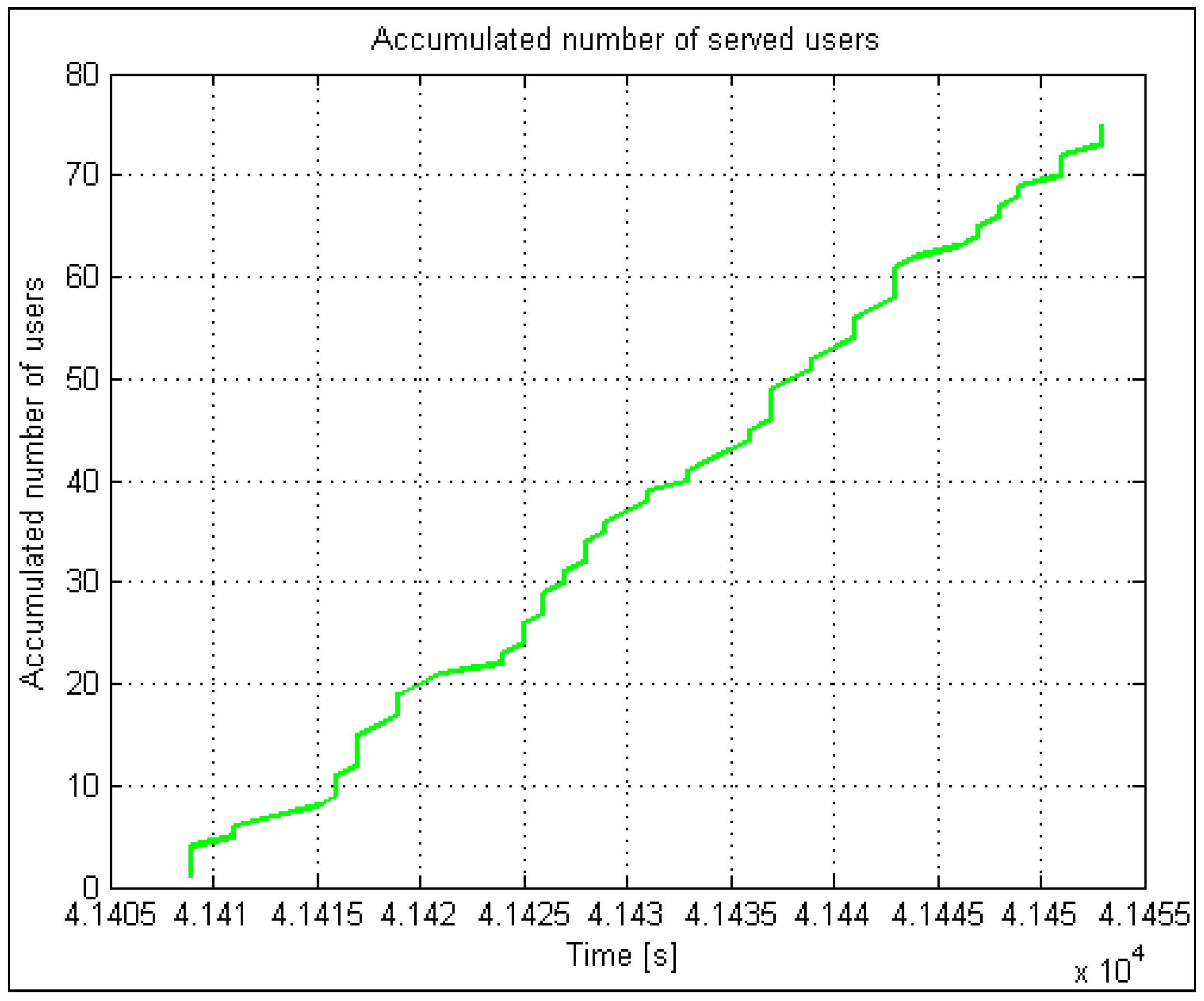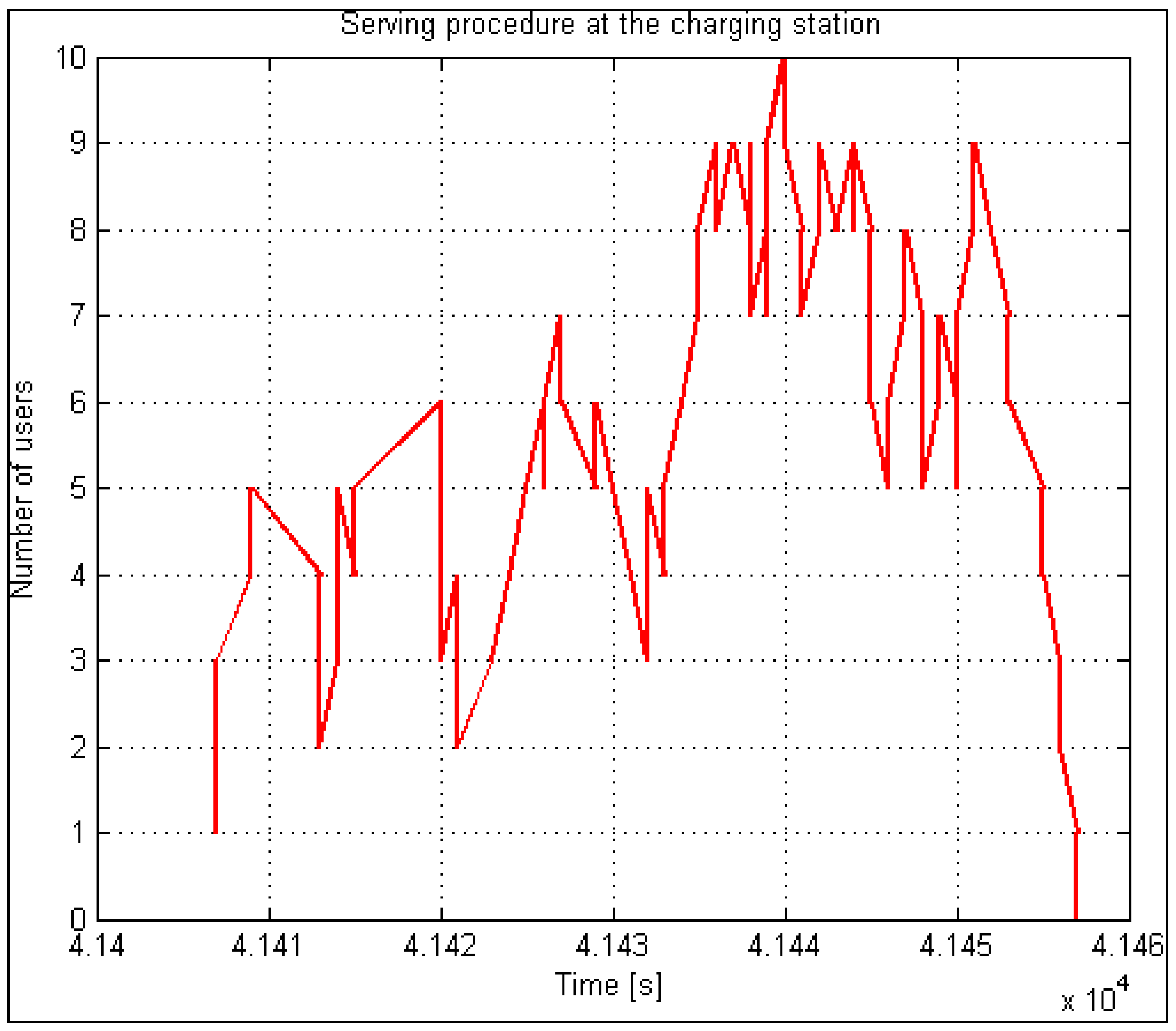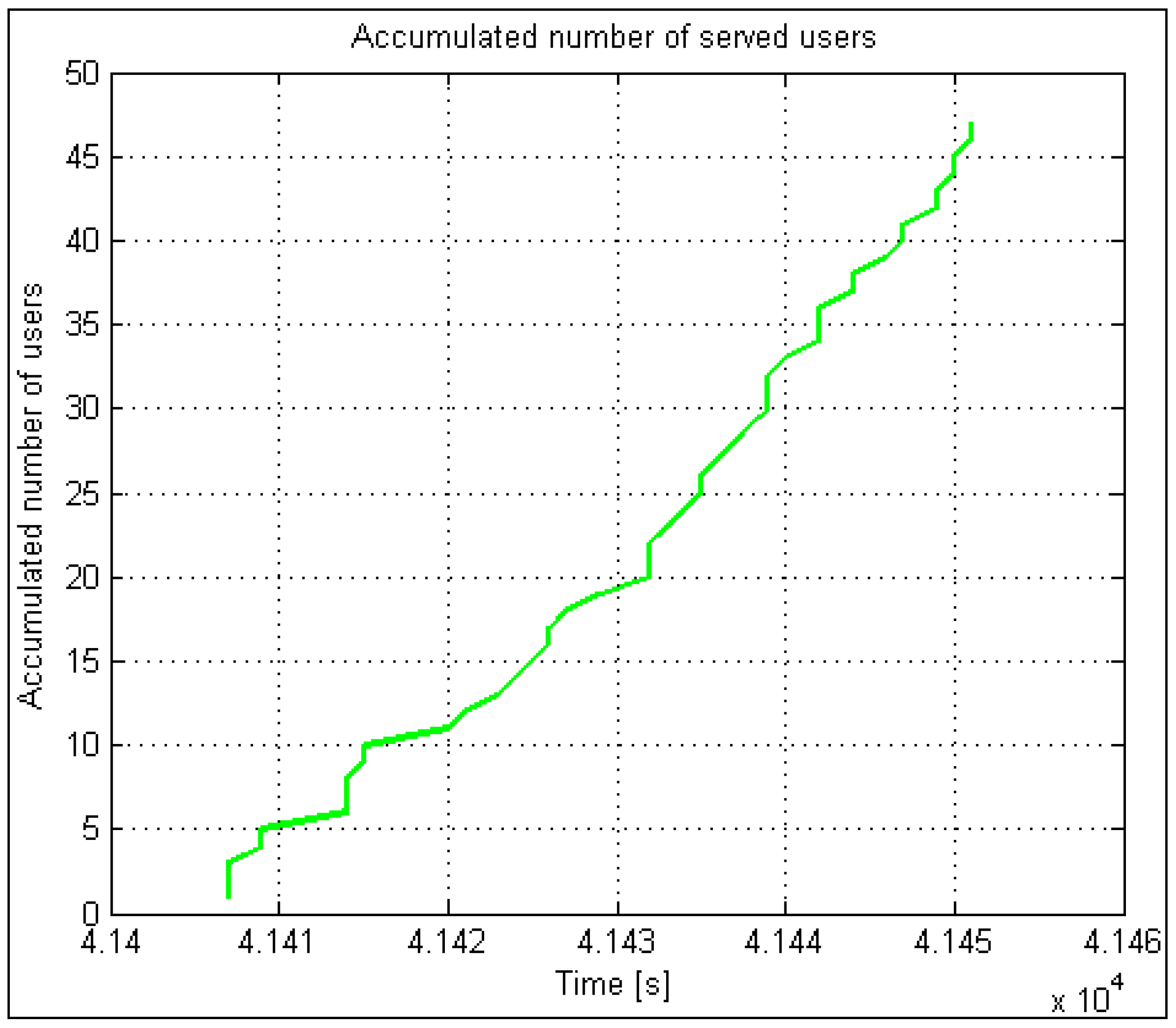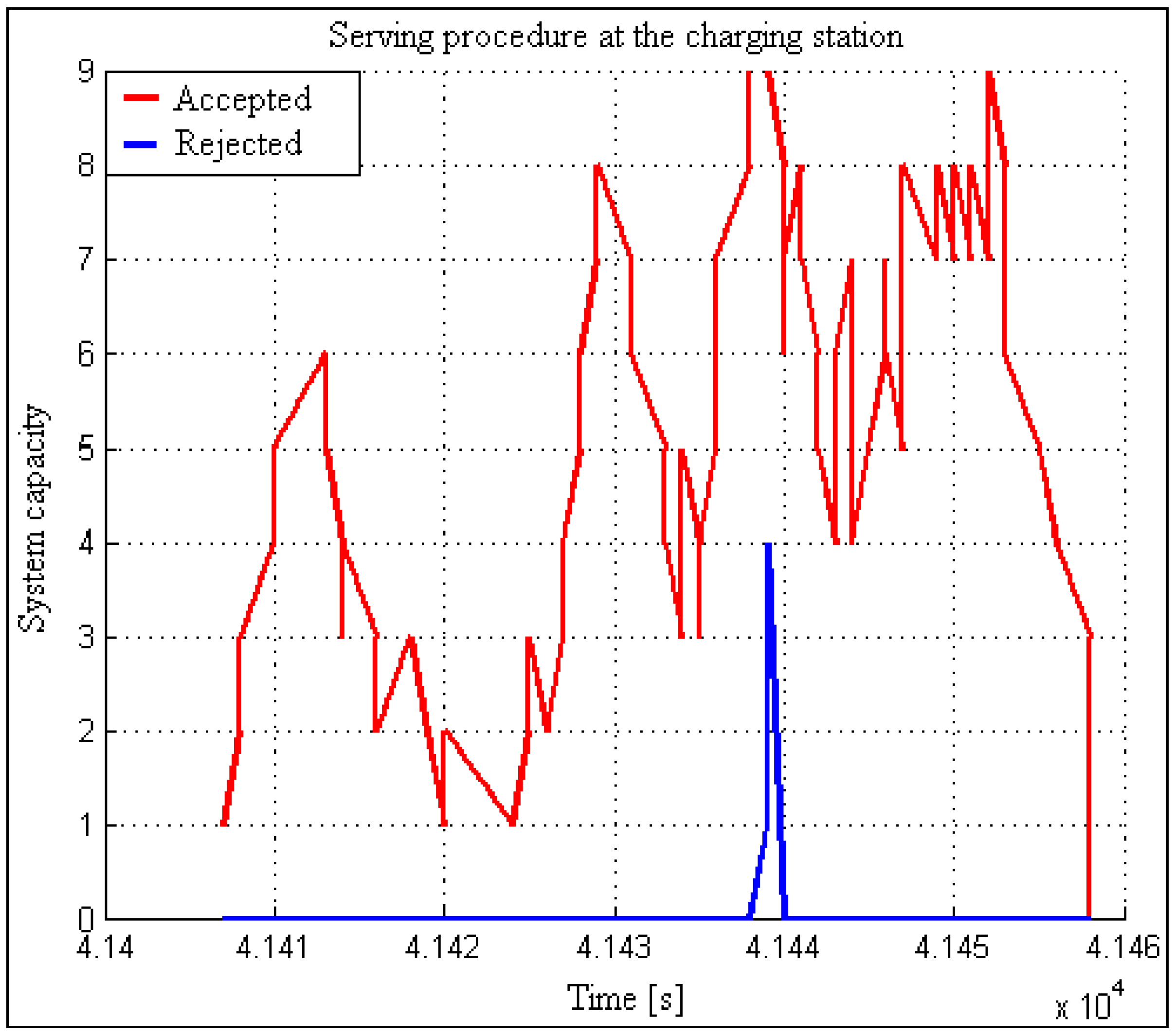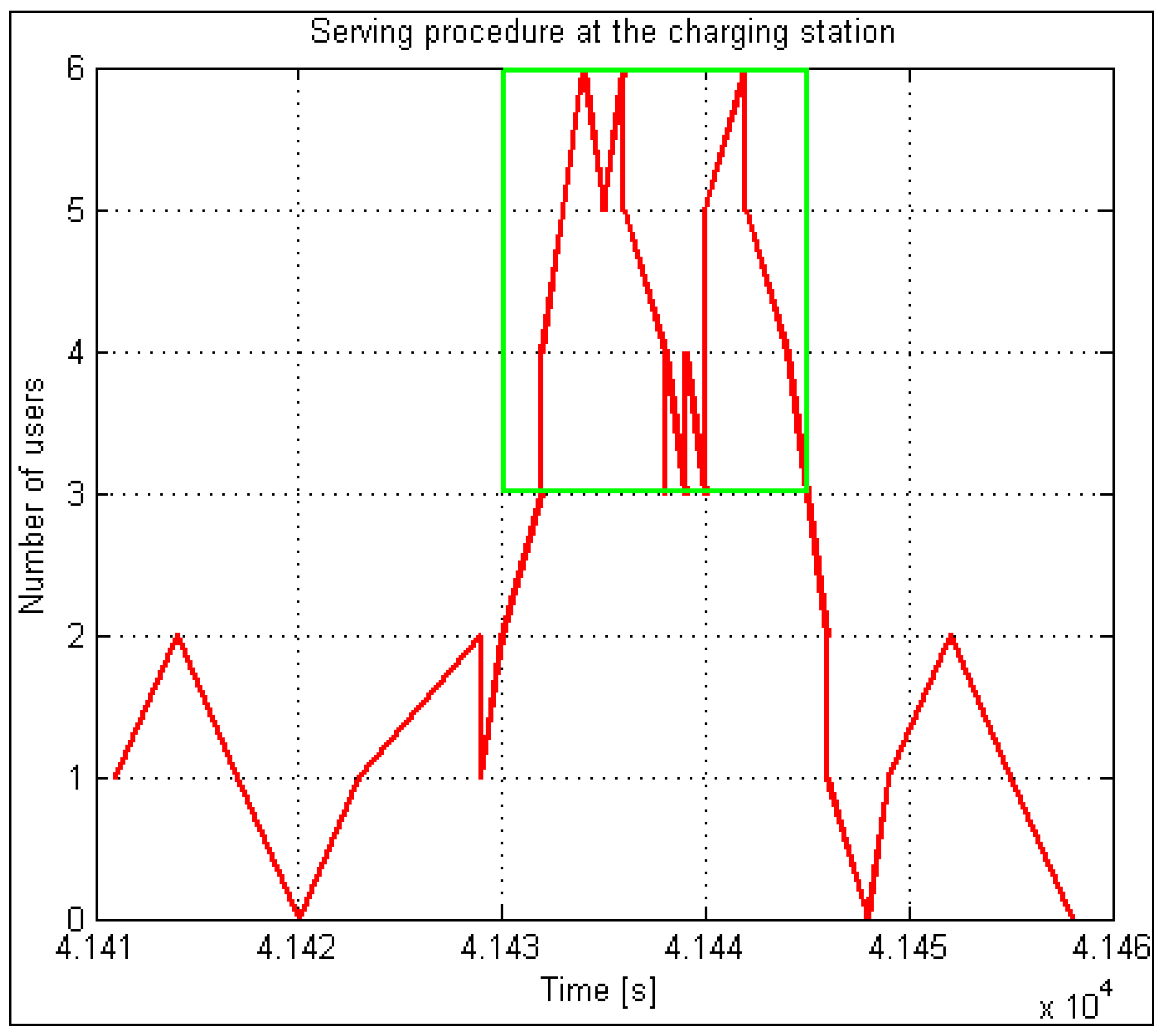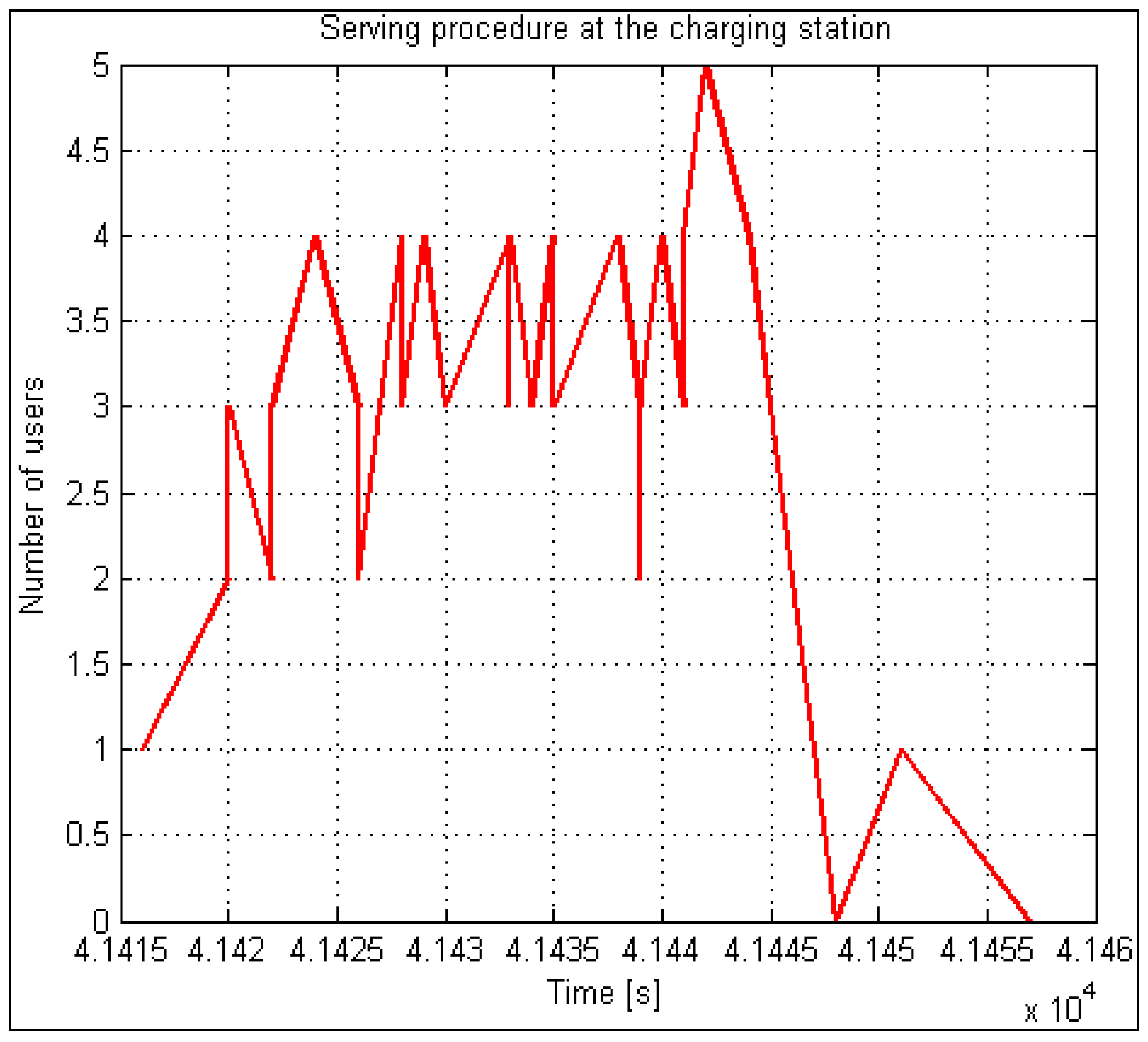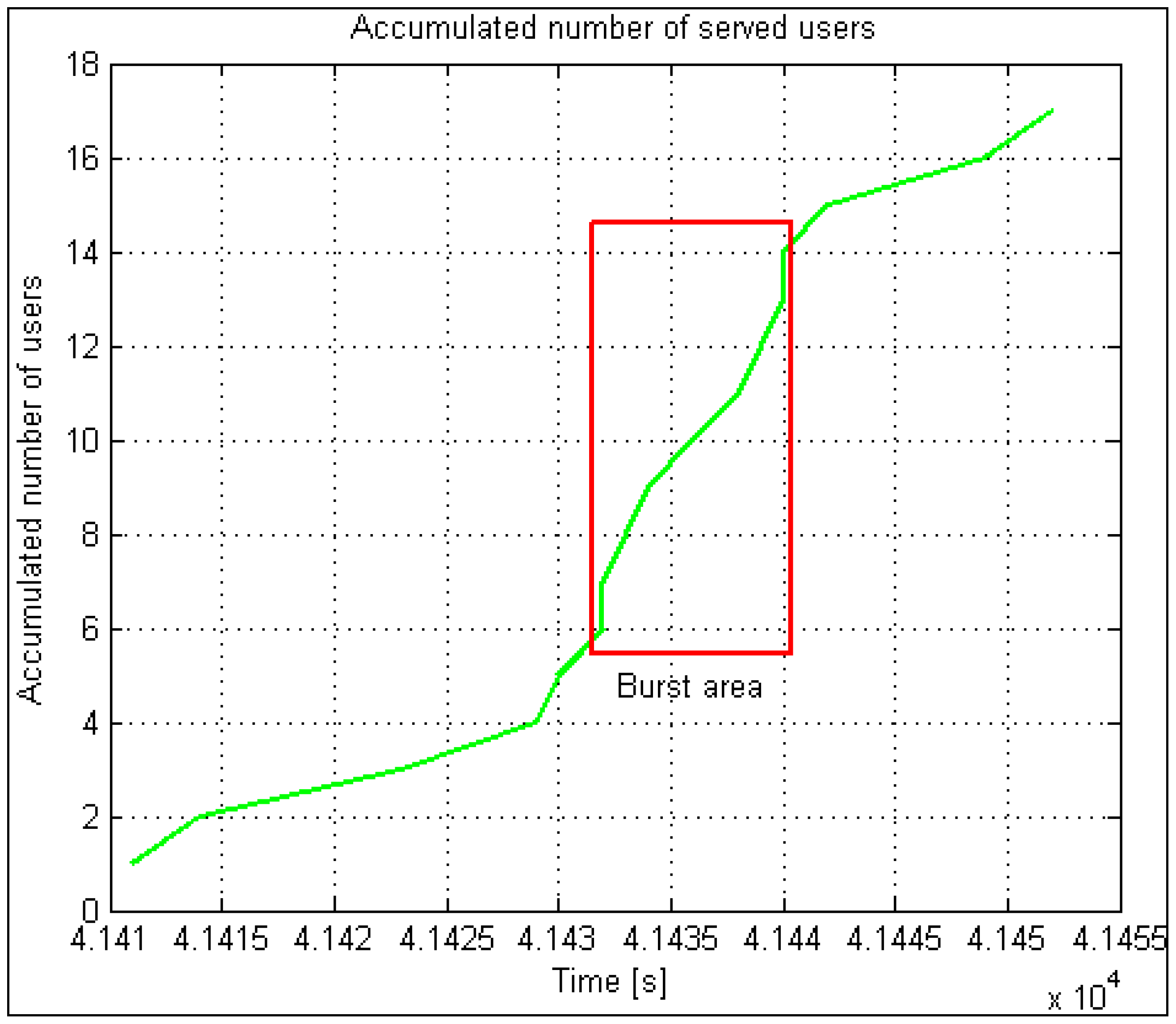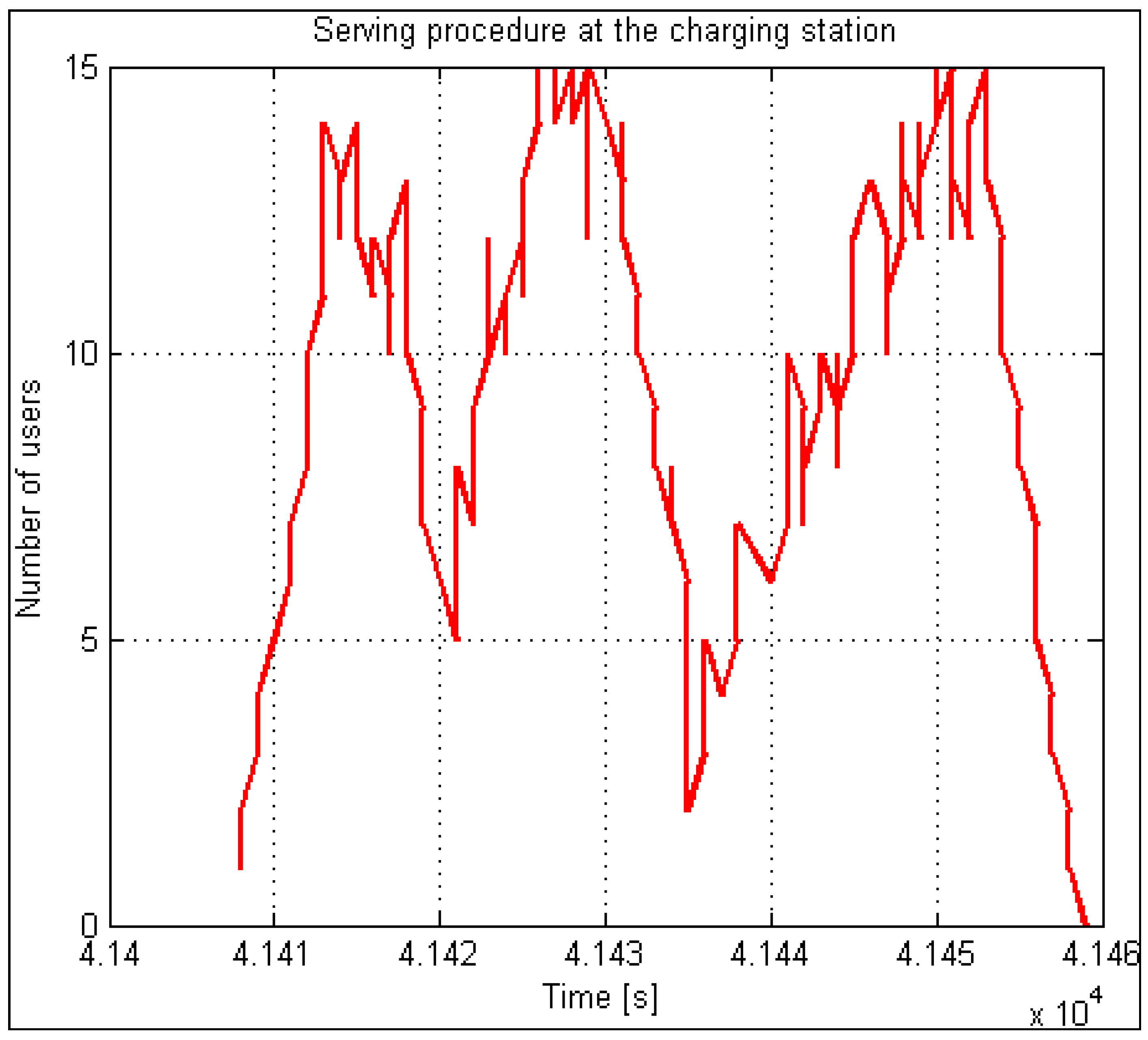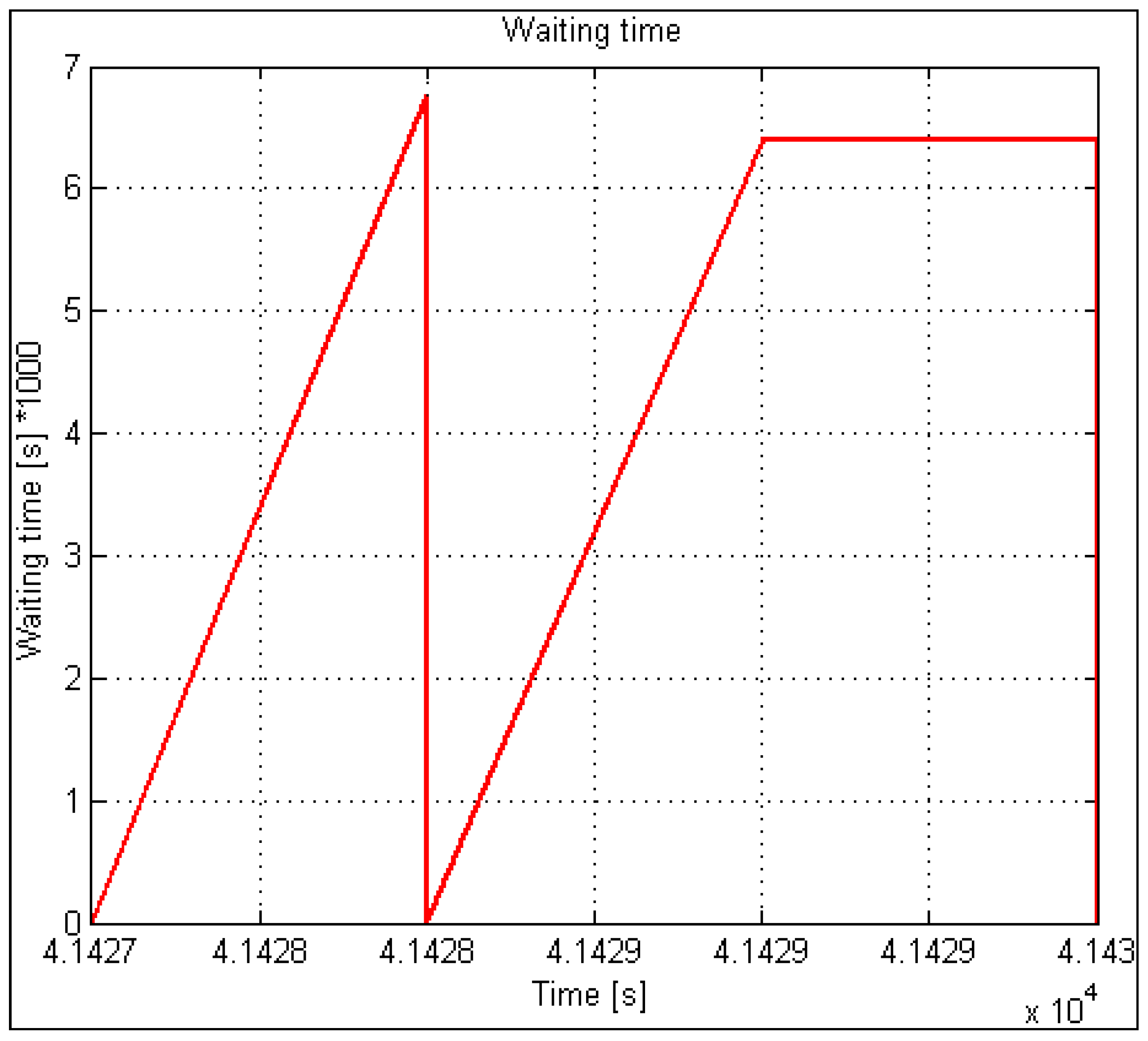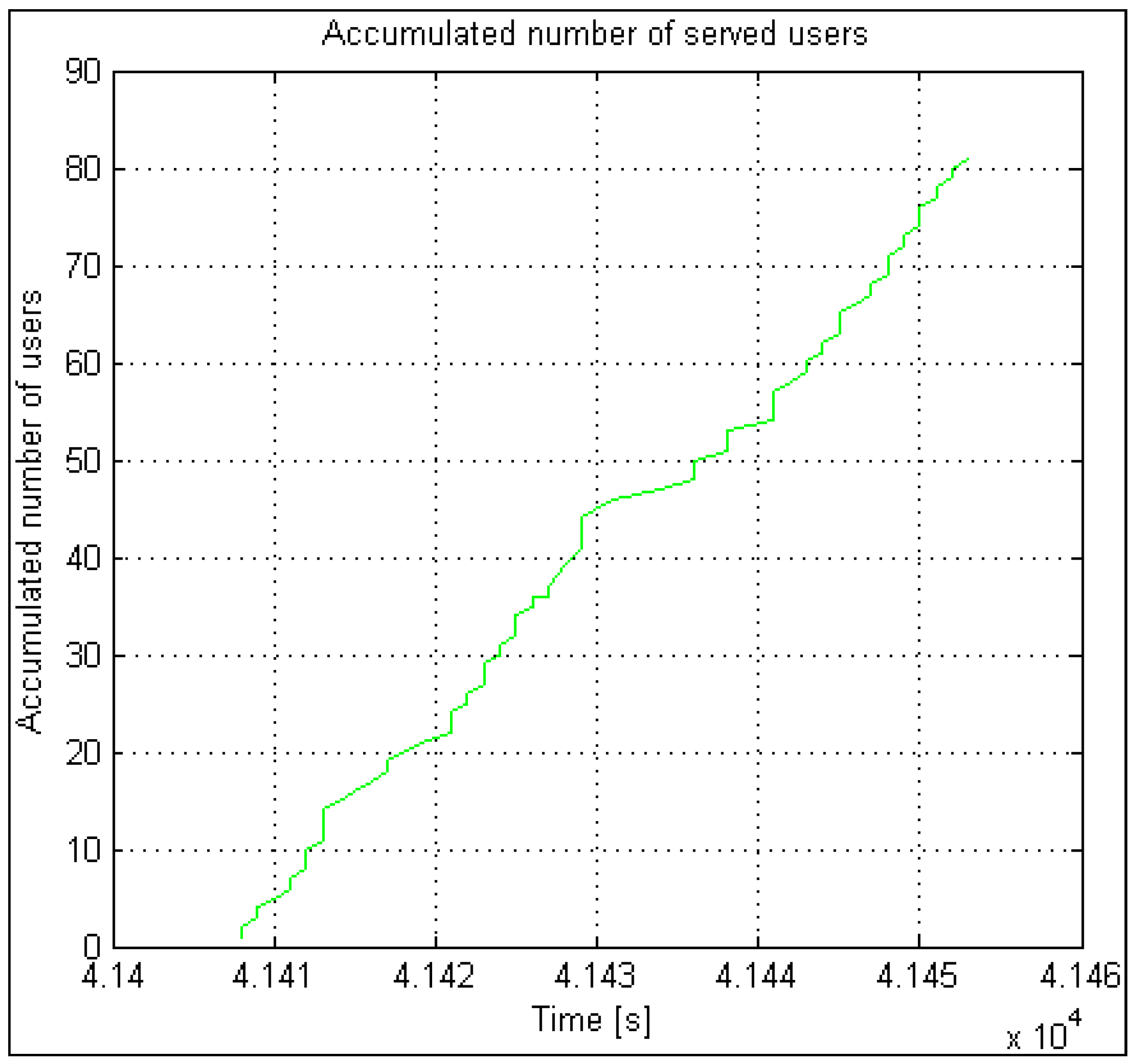1. Introduction
Environmental awareness and the energy crisis are two main reasons for the revival and rise of the electric vehicle (EV) industry. Though electric mobility is still relatively new, the development of electric vehicles and charging infrastructures has been in full swing recently. There is a strong correlation between the two. An adequate charging infrastructure is necessary and relevant for EVs to succeed and thrive on the market. Public charging infrastructure that allows EV users to recharge their vehicles quickly and comfortably is critical to enabling EV adoption on a large scale [
1,
2]. The process of building a network of EV charging stations is complex and costly. Several conditions must be met simultaneously for an EV charging station to be economically justified at a specific location. The essential requirement for an EV charging station is the user’s need, followed by the availability of infrastructures, such as electricity distribution infrastructure, roads, and municipal infrastructure. Those conditions lead to selecting the most appropriate technology for the EV charging station. It must satisfy the widest circle of potential users in terms of its functionality and, simultaneously, be as affordable as possible. A variety of EV charging stations are available on the market, from simple and inexpensive AC versions to high-performance, fast DC charging stations.
The diversity of EV charging stations is increased by numerous solutions in EV vehicles, such as various power connectors, different AC/DC and DC/DC converters, and other technical details [
3,
4,
5,
6], further complicating the planning of EV networks. Due to the interdependence of EV charging infrastructure and the widespread use of EVs, the construction of EV charging stations in local communities has been heavily subsidized in many countries, particularly in the EU. Certainly, the measure encourages the use of EVs. However, laying EV infrastructure in the environment can have negative consequences, such as location inadequacy, technical-performance inadequacy, under-capacity, and over-capacity. In light of what was discussed above, the article investigated primarily the over-capacity and under-capacity problems of the EV charging infrastructure. The research focused on analyzing the use and determination of the optimal use of EV charging infrastructure based on the quantity and demand of potential users. Technical and performance differences between different versions of EV charging stations were excluded in the research, so the proposed method is agnostic from this perspective.
Planning the required capacity of service systems is described in various research studies [
7,
8,
9,
10,
11]. Planning capacity is a strategic process of finding optimal solutions depending on the available resources and current business requirements to ensure the highest possible level of service quality, taking into account the factor of cost minimization. It is a critical and sensitive process, closely connected to capacity management, service level management, and the so-called configuration management or configuration administration [
12,
13,
14].
Capacity planning in information technology is the science and art of estimating future requirements for space resources, computer hardware, software, and connectivity infrastructure [
15]. We use capacity planning in various fields, such as energy consumption, hardware resources, hardware capacity planning [
16,
17], road capacity planning, business cost planning, human resource planning [
18], etc. By using the planning methods, we can plan higher utilization of the existing equipment and look for ways or features with which we can influence reduction and optimization. This way, we can look for solutions for unimplemented (inexistent) systems, which are only in the phase of planning [
8]. With the acquired planning solutions (depending on the accuracy of the solution—the use of an appropriate method), we can relatively quickly answer whether the chosen solution will fulfill our needs, to what degree, and in what scope is an investment rational.
The area of capacity planning and optimization [
19] is a research area with specific well-known methods [
7], where factors such as system dynamics, random timing of system events, and especially nonlinear relations are the primary trend of further research in this area. The listed factors are the guidelines for our proposed method, which we present in this paper. Research in this area, whether it concerns man-force planning, production capacity planning, or the suitability of processing systems planning according to the demand trends, has also been stimulated by the recent global financial crisis. People want insurance against unnecessary or wrong investments.
Nowadays, there are two approaches to capacity planning: trending capacity planning [
20] and capacity modeling [
7], the latter being the newer, more modern approach. Trending capacity planning uses historical patterns that include past events. In such a method, a linear trend of increasing and decreasing utilization over a period of time [
21] is designed based on known patterns. An analytical prediction based on a rising and falling trend evaluates the required capacity at a given time. From this point of view, the approach is simple—its only advantage over the capacity modeling method. The disadvantage of techniques based on the linearization process is the high inaccuracy of predictions, since most events in the business world are dynamic.
Moreover, such dynamic systems also contain components of nonlinearity. The nonlinearity is particularly evident in the fluctuation of capacity according to current demand, which depends on higher-level characteristics needed at a global level. Some degree of error in a linear prediction is already inherent in the process itself. This method introduces a further error if we assume that bursts are also present in the system (random, stochastic, unforeseen, sudden loads or spikes) [
22]. The consequence is an even higher level of distrust in the provided solution. The capacity modeling method is one of the modern approaches in the discussed field. Mathematical models based on statistical data, probability distributions, etc., are designed for this purpose. This model, for example, includes the information on the capacity, occupancy, and utilization of the discussed system, as they are (with no approximations, linearization, etc.). The approach enables the generation of various patterns [
23,
24,
25], which can come from statistical data, modification of this data, or practical choice. In such an approach, we also observe the response as an output of the system (in the simulation model or the model of an observed system). In this way, we can test multiple scenarios arising from what-if questions.
Thus, the capacity modeling method allows us to predict resource demand and forecast resource provisioning according to current and future demand, always finding the near-optimal solution. Such a planning approach removes the limitations of search experiments. It enables optimal configuration, arrangement, and reorganization before rash decisions about financial investments or physical changes to a particular system [
10]. This branch is the foundation for new planning solutions, as the number of possible paths or realizations for finding a suitable solution is practically unlimited. Our proposed method of planning and optimizing dynamic service system capacities is a viable solution presented in the next chapter. Existing methods (considering trends, linearizing trends, inappropriate distributions, stochastic, bursts, etc.) are insufficient and inapplicable. Hence, we developed a new solution, the applicability of which will be demonstrated using a real example of capacity planning.
We used the modeling methodology to design a dynamic planning method and optimize service capacities. Research is thus mainly devoted to this section of the work.
1.1. An Overview of the Existent Solutions
In reviewing scientific papers, we see that there are solutions of a similar nature, but they are not universal. We can compare our approach, method, methodology, and advanced tool simulator/emulator to:
Stochastic optimal production control problem with corrective maintenance [
26],
Production planning of a hybrid manufacturing–remanufacturing system under uncertainty within a closed-loop supply chain [
27],
Intermediate storage in batch/continuous processing systems under stochastic operation [
28],
Dynamic scheduling of maintenance tasks in the petroleum industry: A reinforcement approach [
29],
The method, simulation, and analysis of necessary capacities of water supply networks depending on demand and the volume of water in the water reservoir [
30],
Method and simulation of the permeability of crossroads according to temporary traffic volume, number of lanes, the diameter of the roundabout, the randomness of exit allocation, and type of the traffic (mixed, only trucks, buses, only personal cars) [
31],
Simulator of allocation of electric charging stations in tourist centers, where electric scooters are used [
32],
Simulation as a decision tool for capacity planning [
33],
Simulation Platform for MIMO Systems [
34],
Low-Complexity MIMO Channel Simulation by Reducing the Number of Paths [
35],
Airport terminal capacity planning [
36],
Operating Room Planning with Random Surgery Times [
37],
Managing Service Capacity Under Uncertainty [
38],
Call Center Capacity Planning [
39],
Capacity Planning of Ambulance Services: Statistical Analysis, Forecasting, and Staffing [
40].
A number of similar solutions exist (for example, see [
17,
18]); however, none of them satisfy our needs. Throughout research and method development, we strive to build a universal model and simulation scenario.
1.2. A Short Description of the Paper Structure
The paper consists of six main sections. The second section presents the components of the proposed capacity planning method, including mathematical and simulation models. The same section also includes the used optimization method and automatic analysis as an additional component of the presented optimization loop and process. The third section compares our proposed method with a reference method used for charging stations. The comparison focuses on the direct similarities and originality of both approaches. The fourth section presents statistical data used in the reference method. We also use them to directly compare the proposed method with the existing solutions and their validation. In addition, in this chapter, we present several experiments and direct comparisons to justify the suitability of the new method. The fifth section discusses experimental results and some limitations of the method. The final section summarizes the solution’s features, its applicability, and future research directions.
2. Definition of Models in the Proposed Method
The user model includes two types of users:
- (1)
Users with “healthy” batteries that are more or less empty and for which a normal recharging process is performed (described with their normal distribution). Depending on the battery’s empty, the charging time varies (different charging time durations).
- (2)
The so-called “lammer” users have or are about to have a battery failure. Such users stay at the EV charging station for a short period until a charge monitor electronically detects a battery failure. Such an EV is immediately removed from the charging station, which becomes free and ready to accept a new user (lammer users dramatically affect the exchange dynamics at the charging station). They are modeled similarly to real users but again with their normal distribution. The number of such users depends on the percentage of all users. Their appearance in the load pattern is completely pseudorandom.
The following three pairs of models are necessary to determine the charging capacity of an electric vehicle charging station:
- (1)
‘Rush hour’ models that represent the increased/decreased user share—they provide an initial basis for stochastic patterns within the observed ‘rush hour’ where pseudorandom (see stochastic in [
16,
41]) localized stochastic bursts are generated;
- (2)
The models as mentioned above for the lammer and real users; and
- (3)
The service station capacity model.
Each model pair represents one aspect of the process T(n), such as how EVs appear in the system or are accepted into it, and another aspect of the process X(n), such as how long the charging process lasts.
As we mentioned in the introduction to this section, the user model includes two types of users. The first group consists of everyday charging system users whose vehicles have reliable batteries that are not in a state of failing or about to fail. The second group includes vehicles whose charging diagnostic system detects battery failure. The latter occupies the charging slot until the diagnostic system detects a failure. Charging takes place in this location for shorter periods than a healthy battery. Such user behavior has an influential impact on the service dynamics and the permeability of the service system. We introduced a different normal distribution in real-world charging stations for EVs, where many batteries are in a failure state or close to it. Their share can be expressed as a percentage unit of all users (EVs) in the service system. The standard deviation allows us to define time intervals within which the function randomly selects the duration of a battery’s charge or diagnosis. The system handles this by a separate thread, ensuring pseudo-randomness. For this purpose, a normal distribution function is used for lammer and real users, as was defined by [
42].
Figure 1 presents a modified algorithm [
42] used to model the random variable
T, which represents the charging time of each EV, and calculate the probability density function
f(
T). In
Figure 1, a dashed rectangle represents the modified part of the algorithm.
The constants
MODULUS and
MULTIPLICATOR, as well as the polynomials
P(
t) and
Q(
t), are the same as in [
42]. An additional change has been made in calculating parameter
, which correlates to parameter
u, as shown in
Figure 1 in the dashed square. The duration of charging
T is calculated by multiplying the standard deviation
σ by parameter
z and adding the result to the mean value
μ. Furthermore, we consider the limitations of selecting the charging time within the interval based on the
μ and the
σ. A random variable
T has a 68.27% probability of taking a value from within the interval of a normal distribution. We must also consider limitations in terms of a more accurate determination of the charging duration since there is also a high probability that a random variable will take one of the values from the intervals
µ ± 2
σ and
µ ± 3
σ. With all of the above in mind, the procedure for calculating
f(T) has also been changed.
Normal distributions have infinite left and right sides in both the positive and negative halves of the Cartesian diagram, so we can theoretically obtain a negative charging time. However, negative charging time does not exist in reality. Therefore, we introduce an additional limitation where we retain all the characteristics of a normal distribution. We do this by limiting the left tail of a normal distribution. In our proposed method, each normal distribution function has a ± range around its mean value. Whenever the upper or lower limit of the range is exceeded, values are adjusted according to the maximum or minimum value of the range, respectively. Even with the ±3
σ range, we are still on the positive side, so it is very unlikely to choose a negative element. Nevertheless, it is possible. From a mathematical perspective, we can eliminate the normal distribution’s left (negative) tail by utilizing the derivative of the following criterion functions, which retain the definition of the normal distribution despite limitations (see Expressions (1), (3), and (4)).
For this limited normal distribution, marked as
pt(
t), the definition consists of two parts:
The
k factor is calculated from the cumulative distribution function of the left tail of the normal distribution.
Although all the limitations are presented, we ensure that the simulation model is as close to the real-world model as possible.
We used the commercial tool EasyFit [
43] to analyze data patterns for various types of serving systems. In most cases, a normal distribution function provided the best fit. As a result, normal distributions are often utilized in modeling real and so-called “lammer” users.
2.1. Definition of a Model of Charging Station’s Accepting Capacities
The EV charging system is limited in the number of inputs because there are a limited number of charging locations available simultaneously. The number of inputs in the EV charging system determines the actual capacity for servicing multiple users simultaneously. In cases where the EV charging system falls into the saturation of available capacities, there are two possible ways to deal with the user’s request. EV charging systems can either reject the request immediately or queue it and process it according to the FIFO principle.
The model describing the operation of an EV charging system with a constant number of inputs is simple. The EV charging system model inputs are defined by vector
V(
t). The number of variables in vector
V(
t) is equal to the number of inputs of the EV charging system (4). An individual variable can only have binary values, 0 or 1.
Unoccupied inputs of V(t) have a binary value of 0. Whenever the user request appears at the EV charging place, the input variable receives a value of 1 and keeps it until the charging is completed. Upon completion of the charging process, its value changes back to 0, signaling that it is ready for use.
With a normal distribution, all the specifics of the EV charging system are included in the time frame (t) for managing, occupying, and releasing the EV charging places.
At the same time, other inputs can receive users and serve them according to the rules of the duration of the serving activity. For this purpose, we have introduced an additional parameter, Z(t), which records the number of occupied input capacities in terms of time. It functions on the principle of incrementation and decrementation. In the initial state, its value is equivalent to the value of input capacities. Suppose we have ten inputs available (Z(0) = 10). As soon as the service system receives a user, Z(t) is decreased by a decrement of 1. It keeps this value if the serving of a specific user (electric vehicle) is not finished. Every finished “vehicle-user” Z(t) is incremented by value 1. When Z(t) reaches value 0, this is a clear signal that the system cannot receive or serve new demands. The process treats users according to the system operation regime (rejecting, waiting in line). With the introduced parameter, we can examine the utilization of the system over an extended period (a day) or observe usage during peak times. The temporary value of the indicator Z(t) represents the provisional number of free input capacities.
Every input is also indexed. Different charging durations introduce indexation. The ability to determine the currently accessible inputs influences the freeing of input capacities. By doing so, we can load available inputs even when some in-between inputs are already occupied.
2.2. Peak-Load Model
In an analysis of the performance of the EV charging system, the histogram of the number of bursts of demands followed a Gaussian probability density function and showed that, out of all bursts during one day, only one was dominant. Approximately 70 percent of everyday demands come from it. There is a burst of approximately one hour duration in this period, so we call it “peak” or “rush hour”. The charging system simulator implements this model separately in a thread. It can start performing at any point of the probability density function and runs continuously.
Figure 2 illustrates an example of rush-hour traffic. It is evident from the figure that almost 3500 users appear within one hour.
We can determine the normal distribution parameters because we know the number of users within the peak load (statistical analysis) and the duration of such an interval (
Figure 2). According to the increment (left increasing tail), the proposed method generates for users (increment) the times of triggering visits within the interval using pseudo-randomness, which already at the beginning of implementation ensures a random pattern within statistical limits. We can hypothetically (according to
Figure 3) assume to have 200 demands (scooters, users, calls, transactions) within a 15-min interval. Using the statistical data and the previously described procedures, we design a pattern with a reference normal distribution of users increment (left tail—see
Figure 3). The proposed method seeks a solution that satisfies a wide range of load patterns and set criteria. The criteria are set to consider the worst-case scenario results in terms of waiting time, allowable waiting period threshold, and allowed rejection threshold. All load patterns are created from the same statistics. All the listed criteria are considered with the included automatic analysis in the optimization loop, presented in
Section 2.5. It looks for a near-optimal (the expression “near” is used for a reason, as in practice it is very difficult to repeat a pattern that is identical to the previous. Because the method generates a certain number of patterns, the acquired solution is highly probably accurate, but there is still a chance of an untested pattern, for which this is not true. That is why we use the expression “near-optimal”) solution in a manner that is shown in
Figure 4.
The parameters for the peak-load model, which is also based on a normal distribution function, were calculated using many peak-hour patterns managed by the EasyFit tool [
43]. We followed the same approach for the peak-load model as we did for the model for real and lammer users.
2.3. Description of the Algorithm for Triggering EV Charging Event
Data on users, their number, duration, and the charging starts, determined based on previously described and defined methods, are saved in the dynamic data structure. Because the whole method is time-continuous oriented, the demand triggering model is accordingly adjusted. A transaction or call is triggered based on the system time, considering the triggering function’s criteria. A specific thread is used to carry out the triggering operation. The function continuously searches the dynamic data structure. New users are added according to the movement on the normal distribution curve for “peak hour” (
Figure 3) and look for users whose triggering time coincides with the system time. A minimum delay in the range of 10 ms is allowed for searching an extensive data structure with millions of users. We compare the participant’s specific time with temporary real system time during this process. If there is a match, the demand is triggered (on the condition that the user has not been accepted yet, is still active, etc.). In the second step, the function checks whether the abovementioned indicator of available capacities
Z(
t) has a value different from 0. If the answer is positive, the demand is accepted. Suppose not the usual match is treated according to the chosen operation regime (rejection, repeated attempt, or a queue—regimes supported by the proposed method). An accepted demand in the service system takes up the input as long as the completion function does not fulfill the completion criterion. A separate thread performs the completion function with a limited time delay of 1 ms. At the same time, this value represents the lower limit in scaling the parameters for the need to speed up the simulation. In response to the time running out for active demands (flag indicates whether they have been accepted into the system), a thread iteratively searches the dynamic data structure using the temporary system time. Because every user in the dynamic data structure has a defined time of the “transaction” and its duration (see subsection on random assignment of time of demand/charging within the observed interval), the completion is the sum of the start and the duration. From this perspective, we have available all the data necessary for operation. When the thread with the performed criteria completion function determines that the demand ran out, it deletes the accepted flag and puts a completed flag. Suppose the option for reassignment of data to a user, etc., is chosen with the method. According to the procedures mentioned above, the user receives new parameters at the beginning and throughout the duration. Therefore, the user can determine when to “visit” the system again. In this case, the service system’s communication and loading procedures disregard the user. With the release of the EV charge,
Z(
t) increases. We want the model to reflect actual user behavior. For example, if a user does not receive the service, there is a high probability that they will try again. The method can consider these factors in user choice (integrated and implemented). During the simulation, statistical data are collected by accepting, terminating, and rejecting users. Therefore, statistical information is continuously updated on the simulation/emulation tool [
44].
2.4. Applied and Implemented Optimization Methods
Because, in our case, we are generating pseudorandom load patterns with stochastic characteristics within a deterministically defined observation interval, optimization belongs to the area of stochastic programming. For optimization, we first used the method of incrementation/decrementation of the service capacity parameter in terms of the allowed threshold or criterion of rejected users. Because the used method has certain deficiencies (very time-consuming—see paper [
44] about looking for a solution), we provided two different processes to speed up the search for an optimal solution. These are:
tangent method and
the secant method.
In our case, the tangent method has been ineffective since it requires knowing the derivative at a specific point of the criteria function, which is quite time-consuming. We proceeded with the secant method. With it, we avoid finding the derivatives of the criterion function in specific points. For this purpose, we substitute the derivative of a specific point with an assessment, written down as a differential quotient (5):
To assess the next element, an approximation in the secant method, we use the following iteration Expression (6):
Considering the representation in the Cartesian diagram, the difference (
) represents the interval on the abscissa marked as (Δ
a). The difference of functions [
f(
an) −
f(
an−1)] for the chosen points represents the interval on the ordinate marked as (Δ
y). Considering the previous equation and the relevant connections, it can be expressed as in Equation (7).
The difference
is then converted into factor
A, which depends on the temporary point
a. The final equation for calculating a new approximation takes the following form:
When carrying out the secant method, we need an initial interval, defined by points and . These are the initial conditions for calculating the successive approximation of the secant method. With every following calculation of an approximation, we are closer to a solution, which leads us under the threshold of allowed rejected demands. Optimization is often performed with this method because it is fast and straightforward (but not as good as the tangent method). There is no need to find the derivative. Still, based on simple iteration, we find the optimal solution, which is lower than the allowable deviation on the condition of two consecutive steps (see the figure below).
Figure 5 shows a real example of a criterion function. A short experiment shows that convergence speed depends on the initial conditions (interval selection). For the threshold of 10% (
Figure 5), we quickly obtain a not necessarily optimal solution. One can find the optimal solution by further bisection of the interval, but the incrementation method mentioned here serves this purpose better [
44]. From this perspective, we find an approximation with a secant method. In the second step, with the combined incrementation/decrementation method, we see the optimal solution with a high degree of repeatability on different load patterns resulting from the same statistical distribution.
Our second step is to find a better solution in the vicinity of the approximate solution using the incremental method. When looking for an improved solution, we consider the repeatability and coverage of a wide range of stochastic load patterns based on the same statistical distribution. When looking for a solution with the secant method, we limit or round up the approximations to integer values because we are looking for the optimal number of service capacities (lines, service places, etc.), which can be described only with the set of positive integers .
2.5. Automatic Analysis as a Feedback Loop in the Optimization Process
For previously described and used optimization techniques based on incrementing or decrementing the service capacity parameter, we also introduced an automatic analysis of simulation results and individual factors as indicators of possible problems in the service system. The introduced factors, presented in detail below, are auxiliary elements in the optimization process.
Every time a thriving demand is accepted or rejected, the algorithm records a time code. The proportionality observation
R(
t) is another factor created using a specific scenario’s collected data. Each sample value calculates the proportionality factor
R(
t), resulting in the characteristic
R(
t).
The time index t represents the sampling time. When R(t) is much smaller than 1, the service system’s predicted number of input capacities is sufficient. Whenever the factor approaches 0.7, there is a high probability that the system will reject requests as it will be overloaded. Calculated concurrently, that is, during the simulation, the factor R(t) provides a good indicator that alerts us to any unwanted events occurring in the system. An important purpose of the factor R(t) is to determine when and where it is rational to increase input capacity (the demand for dynamic relocation of service capacities).
During the simulation, automatic data collection on the rejected and accepted requests for each time tag is also crucial for optimization (
Figure 6). This factor or relation is marked as
K(
t) and called the calculated relation acceptance/rejection curve. Depending on the time, it points out the problematic areas. With Equation (10), we calculate the factor
K(
t).
Regarding time, K(t) is a curve on the lower side limited with 0 and practically unlimited upwards or limited with the relation between the maximum number of all users and the maximum number of available service capacities. The values and the meaning of the obtained curve K(t) are the following: 0 at a particular time index indicates that no input demand has been rejected (capacity is still available, but it is not fully utilized). Otherwise, when factor K at a given time index t has a value different from 0, this means that in this area, rejection of demands happened (when considering the queue in an x-system, factors K and R, and functions K(t) and R(t) are irrelevant and are not considered). In the case of planning and service capacity optimization for systems with queues, function W(t) applies, describing the changing of the queue subject to time. Function W(t) combines the permeability and queuing factors in the optimization process. In this process, the functions R(t) together with K(t) and W(t) are mutually exclusive and depend on the type of the considered service system (with or without a queue). All three presented functions represent automatic indicators of the successful operation of a specific (considered) service system.
The accumulated number of accepted and rejected users and the number of lammer users are vital statistics in automatic results. Calculating the statistical percentage is easy with a balance and a percentage calculation on the accumulative number of lammer users. The same applies to the accumulated number of accepted and rejected users. These data serve for model validation compared to the data acquired from a real system. All the presented parameters significantly simplify and speed up the analysis process and, consequently, the optimization process when searching for a “near” optimal solution.
2.6. Designing the Proposed Method
Figure 7 illustrates the phases of implementation and operation of the proposed method. Automatic analysis is a guideline in terms of time demandingness and complexity. On the other hand, it also serves as a simultaneous link in the feedback connection and optimization process. We look for the necessary number of service places, lines, etc. Trends in software development, methods, simulation tools, etc., are pointing towards a high degree of automatization so that the user or operator is minimally burdened. However, a certain degree of knowledge about the considered area and the accompanying topics is necessary even in these situations. When designing the method described above, we thus focused on minimizing the requirements for such knowledge. The operator obtains the necessary statistics from actual measurements but can also generate them empirically. At the beginning of the simulation, the operator enters the required statistical data. In addition, the operator must decide what type of system to use, i.e., whether users (so-called “transactions”) are repeated or not, whether a queue is included or not, and how users (e.g., transactions) are scheduled during peak load periods. The rest of the analysis is one of the inputs in the optimization process, and an advanced tool automatically performs the optimization. No intermediary intervention is required from the operator to find a near-optimal solution. The operator also has available an empirical regime meant to test
what-
if scenarios. The operator intervenes with a change of statistical input data and observes what happens in the system. The emulation mode is the third regime in which the developed tool with the implemented method can function. In other words, statistical data (transaction lengths, their arrangement, duration, etc.) are read from the “.log” file, which substitutes the segment of the proposed method model where users, transactions, etc., are modeled and generated. In this mode, the user is only interested in how the system behaves in certain moments. With emulation, the proposed method can optimize capacity by optimizing the performance of the services. However, it is more sensible to analyze patterns in a longer time frame and choose from this range of worst-case scenarios, based on which the system is optimized.
An average pattern is used to optimize the existing system through emulation and optimization if no patterns stand out. Its multipurpose nature makes the proposed method and implementation appropriate.
3. Qualitative Discussion
The author in [
32] proposes a simulation model that uses a deterministic approach to perform an analysis whose result is the necessary capacity of charging stations for electric scooters considering random needs and factors. This concept contrasts with ours, where the occurrence of events is deterministic to a certain extent (the assumed number of events can be estimated sufficiently well in the “rush hour”). Still, their occurrence and the formation of patterns are entirely stochastic. Predicting the “rush hour” periods is also a part of the deterministic segment, as we were able to precisely assess when these periods occur for the Margento service system [
44] (analysis of statistical data). For this reason, the proposed method has only the interval of maximum service system load determined deterministically.
In contrast, considering the normal distribution, transaction increment, and pseudorandom assignment of transaction triggering time, the load pattern reflects stochastic characteristics. In other words, this means that transaction occurrence is completely stochastic within a deterministically determined interval, which introduces bursts. The latter need special treatment and can cause long queues and overloads in certain moments in slow systems (poor dynamics), where the discussed charging stations also belong. The author, in his work, does not consider stochastics or potential stochastic bursts but consistently follows the increments of normal distribution in the observed period (from 8:00 h till 18:00 h). Because it is difficult to find the ideal normal distribution in the “rush hour” period on such a charging station, the author, in this case, “smoothed out” all the peaks (bursts) and approximated them with the classic normal distribution. Each such approximation or linearization leads to an inaccurate or only approximate result. We adopted a completely different approach, as normal distribution in generating a stochastic “rush hour” pattern is only basic information on the number of transactions and their increment during a continuous observation. We thus do not delete the bursts but instead recreate them. Since we use a “pseudorandom” thread, we can generate n patterns from the same statistical data. We can find the optimal solution for either the so-called “worst-case” scenario or a solution based on x tested patterns generated from the same seed (same primary statistical data, same length of observation, same normal distribution, etc.). In the case of known input load statistics, the proposed method can work completely deterministically (predictably). We can recreate the load pattern using emulations and automatic analysis of log files.
In the model [
32], the author supposes he knows the loads of individual charging station locations, the number of active/functioning charging places, the time component of battery charging, and bottlenecks (primary data for the proposed method). By using statistical functions based on measured data, the author in [
32] models individual charging stations’ service.The author thus largely depends on the statistics of the average utilization of charging stations. This statistic is, for him, an indicator for the potential relocation of charging stations (relocation in terms of geographic position—irrelevant for us) or an indicator for increasing the number of charging places (our area). Considering the parameter of average utilization is, from our perspective, somewhat risky, as a single burst in the service system with a slow dynamic (which a charging station is) can cause long queues. This method can also solve the problem of relating the number of service places with the waiting time or rejection.
If we compare the two methods again, we do not consider it wise to rely on average utilization, which we have already shown and confirmed in [
44] (see the second experimental scenario). In this area, the stochastic burst has too much influence on the accuracy and suitability of the final result.
The author used linearization to design and model his solution. He used this method to solve the problem of the number of kilometers covered and the time of charging (depending on how empty the electric scooter battery is). Such an approach contradicts our idea, as we do not introduce simplifications. Still, we consider the situation as it is or might be in the future (prediction ability).
Based on those mentioned above, one single station can be, in terms of behavior, treated the same as the service system presented in [
44]. As a result, we can use the proposed method to plan and optimize the number of charging places at the consideration charging station (see next section). It is possible to translate the model of users, transactions, and calls from the system [
44] into the model of electric scooters in the observation interval. Changing the parameters of the normal distribution function of the relevant model allows us to convert the transaction model into the model of the charging duration. It includes a broad spectrum of users (empty batteries, partially empty batteries, nearly full batteries, etc.). The author does not consider the factor of batteries with a failure, which often appears in practice, especially in the high intensity of charging. Still, it can be regarded as the proposed method, including a model of lammer users (transactions, calls). The latter can be analogically translated into the model of charging duration for batteries with a failure, again with a modification of normal distribution, which in our method and consequently also in the simulation/emulation model is used to describe lammer callers.
Like us, the author divided the problem into several more minor issues, where he systematically modeled each segment individually. In this respect, we are equivalent. In the proposed method, we consider individual segments (charging duration, partially full batteries, the percentage of batteries with a failure, etc.) separately with submodels within the entirety. In statistical data processing, the author concluded that a normal distribution could describe the average speed of electric scooters. They came to the same conclusion when describing the stops at individual tourist points. From our point of view, these data are irrelevant because we do not plan the geographical positioning of charging stations but use the method of precise planning and optimization of charging points. For this reason, the included feedback automatic optimization loop with an optimization method, automated result analysis, etc., is vital for the proposed method and represents an additional difference between the methods. In these terms, we rely on the statistical data in the observation interval [
32] and the data on charging duration and data on battery emptiness which the author determined with the mentioned normal distributions (average speed, stops, etc., factors that influence the final condition of the battery in every electric vehicle). The state of the batteries at charging stations is the starting point for directly comparing our proposed and reference methods.
5. Results Discussion
Using a practical example and a direct comparison with the existing method, we have shown and highlighted the proposed method’s aspects, allowing for more accurate operation capacity planning. There are several aspects of this method, including continuous simulation that allows emulation (actual load pattern), the pursuit of repeatability despite random patterns, automatic optimization, the search for an optimal solution with a high degree of repeatability, the focus on bursts rather than average load, and the consideration of the boundary criteria (the allowed threshold for rejected users, allowed or acceptable waiting time).
While presenting simulation results, we emphasized detailed assessment, prediction, and optimal results according to the set criteria (waiting time, allowed rejection threshold). These are the aspects excluded from the reference method. Another aspect of the direct comparison is the “smoothed out” burst in the reference method, which in our case has a crucial influence on the service system’s behavior and dynamics. Because the author with the reference method relied on average utilization, our goal was to prove that this is risky. Given the results, our conjecture has proved correct. A direct comparison of the first and fourth experiments yields interesting results that uniformly support our hypothesis of the concentration of the load pattern among an additional six users, despite a relatively low average load on which the author relies. Finally, the fourth experiment also predicts what can happen in the system in a worst-case scenario if the number of users increases for a specific percentage. The limitations of the proposed method remain with events that can be described by a normal distribution, especially “rush hour” events, which usually have this property. Future work plans to include other standard distributions already included in the method but not currently used. These include equal distribution [
45] (rarely used), Pareto distribution [
46], exponent distribution [
47], Pascal distribution [
48], Bernoulli distribution [
49], chi-squared distribution [
50], lognormal distribution [
51], Erlang distribution [
52], geometric distribution [
53], Poisson distribution, etc.
Contribution
The following are some advantages and novelties of the method presented in the article:
When generating models, the method uses real data without simplifications, linearization, data filtering, etc., so the system can be treated exactly as it is.
Enables simulation of extraordinary events and emulation based on real-life load patterns.
It is able to handle demand bursts and boundary demand loads in a manner that has the most significant possible similarity with real service system performance.
It incorporates a large number of potential patterns of load system scenarios. It allows the near-optimal solution of the system capacity to be found with a high degree of repeatability and fidelity.
A new feature is the automatic analysis and searches for the optimal solution based on the criterion functions K(t) and R(t).
The application of the method is not only limited to addressing the capacity issue of the EV charging systems but is able to be used in the broad field of planning, installation, and optimization of similar serving systems.
The proposed method also includes an emulator function to facilitate comparison between the simulated and the real results (obtained based on statistical data of a real system). It copies system behavior, and an actual load pattern appears at the input. Validation is, in this case, only a matter of comparing the statistically modeled pattern, including bursts with a real pattern. The same also applies to the results. We should emphasize that the method can, in the emulation function, also optimize the predicted assessment of service capacities.
6. Conclusions and Perspectives
The paper shows the method’s suitability without introducing simplifications, linearization, or optimization of an individual scenario. Investments depend on a precise assessment in hierarchically higher branches (planning, choosing a suitable solution, production, marketing, or economy). If an error is introduced already in the lowest hierarchical department (through simplifications, rule-of-thumb assessments, incorrect methods, or analysis planning), the error is accumulated and transferred to the next level. From this perspective, comparing our method with the reference method was very important. We proved that detailed planning, optimization, and prediction of future needs are possible with modeling, statistics, statistic distributions, pseudo randomness, and stochastics according to general trends.
The method and accompanying research and development are ongoing. The method has already been extended with a scaling and acceleration mechanism and implemented with new optimization mechanisms compared to the method, algorithm, and tool described in [
44]. In addition, the algorithms and functional sequences are in the optimization phase. This version works with a millisecond resolution representing the lower limit of volume scaling (charges, transactions, services, call duration, etc.). Since the method is intended for planning, predictions, and optimizations, as a decision element with a real system with statistical data from the real system’s concurrent log files and as a load element of the real system, the last function is one of significant priority to be developed and implemented.
